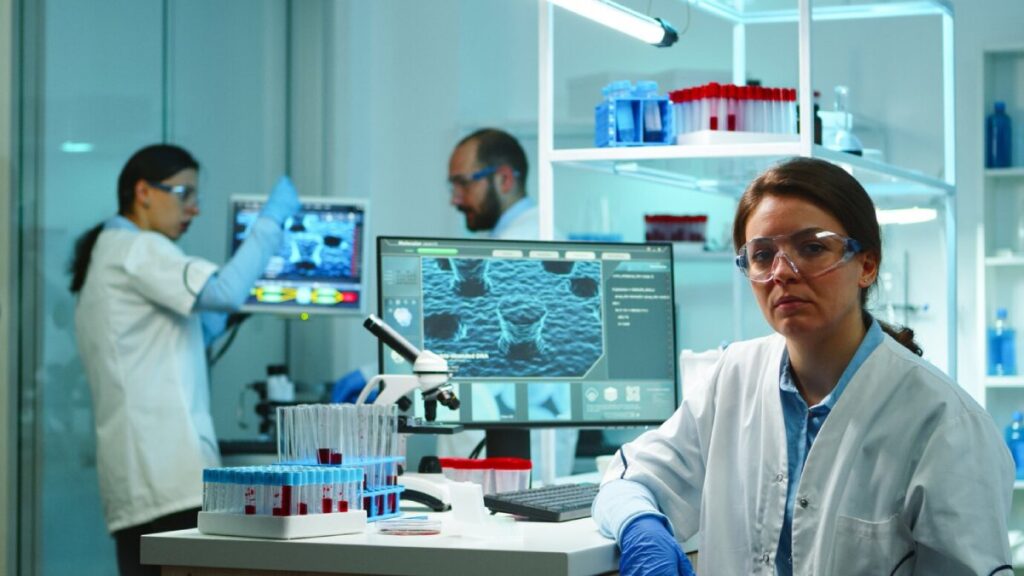The Science Blog

AI in Drug Discovery: Accelerating the Search for Cures
Imagine a world where the search for life-saving medicines no longer takes a decade or more. A world where supercomputers quickly scan millions of compounds each night. They find potential cures for diseases faster than ever. Welcome to the age of AI in drug discovery.
AI is a hot topic in many fields, but in pharmaceuticals, it’s making a real impact. It’s fundamentally transforming how we discover, design, and develop new drugs. The global rise in diseases and the need for personalised treatments make AI in pharma essential now.
In this guide, we’ll look at how AI speeds up new drug discovery. We’ll also check out real-world examples and breakthroughs. Finally, we’ll talk about the chances and ethical issues that this advanced technology brings.
The Traditional Drug Discovery Process: A Slow and Costly Journey
Understanding the Timeline
Traditionally, bringing a new drug to market can take 10–15 years and cost upwards of $2.6 billion. This lengthy timeline includes:
- Target identification – Discovering a biological target involved in a disease.
- Hit identification – Finding chemical compounds that affect the target.
- Lead optimisation – Modifying compounds for better efficacy and safety.
- Preclinical testing – Laboratory and animal studies.
- Clinical trials (Phases I–III) – Testing on humans for safety and effectiveness.
- Regulatory approval – Review by bodies like the MHRA or FDA.
High Failure Rates
Despite the cost and time, only 1 in 5,000–10,000 compounds makes it to market. Many fail due to a lack of efficacy, safety concerns, or unforeseen side effects. This inefficiency creates a critical need for smarter solutions — and that’s where AI-powered drug discovery comes in.

How AI Transforms Drug Discovery
Data-Driven Discovery
AI thrives on data — and the pharmaceutical industry has no shortage. By analysing large datasets from genomics, proteomics, patient records, and research papers, AI can:
- Identify new drug targets.
- Predict how molecules interact with targets.
- Optimise compound properties.
- Forecast potential side effects.
Key Technologies Involved
Some core AI and machine learning (ML) methods include:
- Deep learning: For pattern recognition in complex datasets.
- Natural language processing (NLP): To mine scientific literature.
- Generative models: To design novel compounds.
- Reinforcement learning: For iterative optimisation of molecules.
Real-World Examples of AI in Drug Discovery
Insilico Medicine
In 2020, Insilico Medicine used AI to find a new drug for fibrosis in just 46 days. This normally takes several years. The compound has since advanced to preclinical trials.
BenevolentAI
BenevolentAI identified a potential treatment for COVID-19 using its AI platform. In just weeks, it identified baricitinib, a drug for rheumatoid arthritis, as a candidate. It was later approved for emergency use.
Exscientia
UK-based Exscientia developed the world’s first AI-designed drug to enter human clinical trials. Its candidate for obsessive-compulsive disorder was developed in only 12 months. This shows how fast and efficient AI can be.

Benefits of AI in Pharmaceutical Innovation
1. Speed and Efficiency
AI cuts the time from finding a target to starting clinical trials. It can change years of work into just a few months.
2. Cost Reduction
Automating tasks and prioritising the most promising candidates helps cut down on R&D costs significantly.
3. Improved Accuracy
AI reduces human bias and error, offering more reliable predictions about a compound’s success.
4. Personalised Medicine
AI helps create treatments designed for each person’s genetic makeup. This change is transforming care for diseases like cancer and rare genetic disorders.
5. Drug Repurposing
AI helps find new uses for existing drugs. This speeds up treatment availability during emergencies, such as pandemics.
Challenges and Limitations
Data Quality and Access
AI models are only as good as the data they’re trained on. Inconsistent, incomplete, or biased datasets can lead to flawed predictions.
Interpretability of Results
Many AI models work like black boxes. This makes it hard to see how they reach conclusions. It’s a challenge for getting regulatory approval.
Ethical Considerations
Using patient data raises privacy concerns. The risk of unequal access to AI treatments exists. This can depend on where you live or your financial situation.
Integration with Existing Systems
Pharma companies often find it hard to use AI tools with old R&D systems. This slows down adoption.
Regulatory and Industry Perspectives
Regulatory Bodies
Agencies like the FDA, EMA, and MHRA are updating their frameworks for AI-driven methods. The FDA’s Digital Health Innovation Action Plan is one such initiative aimed at streamlining oversight.
Collaborations and Partnerships
Major pharmaceutical companies are increasingly partnering with AI startups:
- Pfizer + IBM Watson: For immuno-oncology research.
- GSK + Cloud Pharmaceuticals: For AI-assisted molecule design.
- Roche + PathAI: To improve pathology diagnostics using machine learning.
The Role of Big Data and Cloud Computing
Cloud-Powered Platforms
Cloud services such as AWS, Google Cloud, and Microsoft Azure help AI models. They offer scalable computing power and secure storage for sensitive health data.
Real-Time Collaboration
Cloud platforms let researchers around the world work together in real-time. This speeds up discovery and keeps data safe.
The Future of AI in Drug Discovery
Predictive Biomarkers
AI will help find predictive biomarkers. These are signs that show how well a patient will respond to treatment. This is key for precision medicine.
AI + Robotics
Combining AI and robotics can fully automate lab experiments. This includes everything from making compounds to testing them. As a result, workflows speed up dramatically.
Democratisation of Drug Discovery
As AI tools become more accessible, even smaller biotech firms and academic labs can compete in the drug development space.
Continuous Learning Systems
Future AI systems will constantly learn from new data and clinical outcomes, adapting in real-time to improve predictions.
Conclusion: The AI Revolution in Drug Discovery
AI is not a silver bullet, but it is undeniably a powerful catalyst in the realm of biotech innovation. AI is changing medicine by cutting development timelines, lowering costs, and offering personalised treatments.
As we enter precision medicine, AI, big data, and biotechnology merge. This leads to cures that are faster, smarter, safer, and fairer. Embracing AI in drug discovery isn’t just an option — it’s the path forward.
If you’re involved in biotech, pharma, or healthcare innovation, now is the time to explore how AI can enhance your R&D efforts. Integrating AI into your workflow can be a game-changer for your organisation. You can achieve this through partnerships, platforms, or pilot projects.









